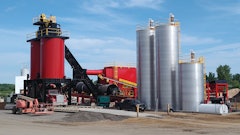As new construction projects continue to focus on attaining Leadership in Energy and Environmental Design (LEED) ratings, pavement maintenance contractors will want to become familiar with LEED standards. Certified LEED projects receive ratings of silver, gold or platinum based on the credits received from various aspects of the building process.
One specific area contractors are seeing an increase in project requests is for pavement coatings because of the LEED points buildings can receive. "It is becoming more important for businesses to obtain LEED credits," says Ted Fritzen, project manager for the stamped asphalt division at Goodfellow Bros located in Maui. "You achieve the LEED points [for pavement coatings] based on the percentage of square-footage that is covered in the coating."
Goodfellow Bros. is a fourth generation, family owned business that focuses on heavy construction work including moving dirt, site prep, etc. In the past 15-20 years, Goodfellow Bros. has offered paving services adding a decorative focus in 2006. With decorative asphalt, Goodfellow Bros. also applies pavement coatings to the surface.
Currently, less than 10 percent of Goodfellow Bros. revenue comes from decorative asphalt, and it has recently seen a change in customer requests for those services. "Originally we were completing more decorative stamping work than coating work," Fritzen says. "Now, we are completing more coating work followed by decorative stamping."
Fritzen has also seen an increase in specifications calling for StreetBond or an approved equal material to be used for projects. Due to such requirements, Goodfellow Bros. has experienced additional opportunities because few contractors are certified to apply StreetBond materials in Hawaii. "Originally, contractors were required to be certified applicators by StreetPrint in order to use the stamped asphalt system as well as the StreetBond products," Fritzen says. "Now, any contractor can purchase the StreetBond material; however, you must be a certified applicator to be able to provide a warranty to your clients."
USS Arizona Memorial Pathways Project
With a four man crew, Fritzen completes pavement coating projects for a variety of facilities including national parks and universities. Goodfellow Bros. recently worked on the USS Arizona Memorial Pathways, a facility constructed to attain LEED silver rating. His crew applied pavement coatings to qualify for the LEED program under Section SS Credit 7.1 Heat Island Effect: Non-Roof.
At 90,000 square-feet, the project was divided into two phases to allow the memorial to remain open to visitors. "The first phase was 50,000 square feet and the second phase was 40,000 square-feet," Fritzen says. "The average width of the surface was between 8-10 feet with additional large common areas that held benches and displays."
Prior to applying the pavement coatings, Fritzen and his crew pressure washed the surface to achieve the best possible bonding with the concrete and asphalt surfaces. "Due to the heavy activity level on the project, including landscapers moving plants and soils and other trades with construction equipment operating on the surfaces prior to our appearance on site, there was a lot more cleaning that had to be done than with normal projects."
The crew also had to mask structures, lampposts, benches and landscaping to protect the areas from overspray.
Using sprayers, the crew applied the coating in four coats: two base coats that contained more fines and two topcoats. Fritzen used StreetBondSR—Solar Reflective coating in Sandstone. "The coating thickness is very thin. The process involves spraying the coating and then brushing it with a medium stiffness broom to insure that is gets evenly distributed," Fritzen says. "This is especially true of surfaces that have been stamped with patterns. As the coating cures, it dries and also undergoes a chemical change that aides in binding it to the surface. That is why the application is done in two to four coats. The thickness after four coats will still not present any issues such as elevation differences at borders that could be trip hazards or noticeable differences between two areas.
Due to the intensive UV exposure in Hawaii, StreetBond products can be applied to help protect the pavement. One advantage StreetBondSR provides for pavement protection is a Solar Reflectance Index greater than 29, a requirement for receiving LEED points.
Teaching the client
As products and applications continue to gain momentum in the industry, it is always essential to teach potential clients about the benefits of a product and service. Fritzen encourages contractors to hold demonstrations of pavement coating applications. Goodfellow Bros. held a demonstration at Oahu for architects, engineers and government workers to share the advantages of StreetBond. Due to the demonstrations, Fritzen received several inquiries from both private, commercial and government clients.
"At the demonstration we discussed the advantages of our coating products over petroleum based 'sealcoat' products," Fritzen says. "The minute you walk away from a traditional sealcoat the surface starts breaking down and oxidizing caused by exposure to the sun. Sun exposure is also a main cause of the asphalt degradation that created the need for the seal coat in the first place. Our coatings are a water based polymer that offers great UV protection to the asphalt surface."
After viewing the presentation, the observers were pleasantly surprised with the product. "People were surprised to hear a 'paint' would be durable enough to withstand vehicle traffic," Fritzen says. "They couldn't believe it could provide protection that will extend the life of the pavement. It is more environmentally friendly by first being a water-based versus petroleum-based material and second by offering solar reflectivity that reduce ambient temperatures around urban landscapes."

























